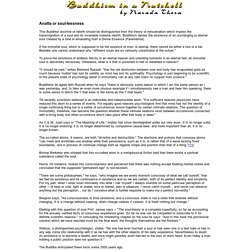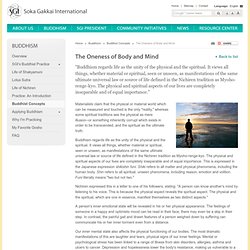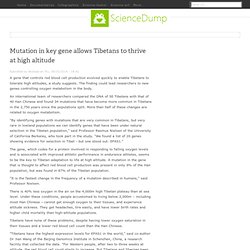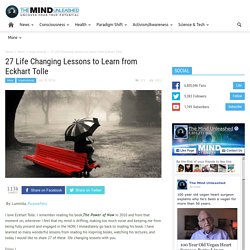

Buddhism in a Nutshell - Anatta. Anatta or soul-lessness This Buddhist doctrine of rebirth should be distinguished from the theory of reincarnation which implies the transmigration of a soul and its invariable material rebirth.

Buddhism denies the existence of an unchanging or eternal soul created by a God or emanating from a Divine Essence (Paramatma). If the immortal soul, which is supposed to be the essence of man, is eternal, there cannot be either a rise or a fall. Besides one cannot understand why "different souls are so variously constituted at the outset. " To prove the existence of endless felicity in an eternal heaven and unending torments in an eternal hell, an immortal soul is absolutely necessary.
"It should be said," writes Bertrand Russell, "that the old distinction between soul and body has evaporated quite as much because 'matter' has lost its solidity as mind has lost its spirituality. Till recently scientists believed in an indivisible and indestructible atom. As C.E.M. The Oneness of Body and Mind. Back to list "Buddhism regards life as the unity of the physical and the spiritual.

It views all things, whether material or spiritual, seen or unseen, as manifestations of the same ultimate universal law or source of life defined in the Nichiren tradition as Myoho-renge-kyo. The physical and spiritual aspects of our lives are completely inseparable and of equal importance. " Materialists claim that the physical or material world which can be measured and touched is the only "reality," whereas some spiritual traditions see the physical as mere illusion--or something inherently corrupt which exists in order to be transcended, and the spiritual as the ultimate truth. Buddhism regards life as the unity of the physical and the spiritual. Nichiren expressed this in a letter to one of his followers, stating: "A person can know another's mind by listening to his voice. A person's inner emotional state will be revealed in his or her physical appearance. [Courtesy April 1999 SGI Quarterly]
Timeline Photos - Meditate in Melbourne. Mutation in key gene allows Tibetans to thrive at high altitude. A gene that controls red blood cell production evolved quickly to enable Tibetans to tolerate high altitudes, a study suggests.

The finding could lead researchers to new genes controlling oxygen metabolism in the body. An international team of researchers compared the DNA of 50 Tibetans with that of 40 Han Chinese and found 34 mutations that have become more common in Tibetans in the 2,750 years since the populations split. More than half of these changes are related to oxygen metabolism. "By identifying genes with mutations that are very common in Tibetans, but very rare in lowland populations we can identify genes that have been under natural selection in the Tibetan population," said Professor Rasmus Nielsen of the University of California Berkeley, who took part in the study.
"We found a list of 20 genes showing evidence for selection in Tibet - but one stood out: EPAS1. " ScienceDump - Timeline Photos. 27 Life Changing Lessons to Learn from Eckhart Tolle. By: Luminita, PurposeFairy I love Eckhart Tolle.

I remember reading his book,The Power of Now in 2010 and from that moment on, whenever I feel that my mind is drifting, making too much noise and keeping me from being fully present and engaged in the NOW, I immediately go back to reading his book. I have learned so many wonderful lessons from reading his inspiring books, watching his lectures, and today I would like to share 27 of these life changing lessons with you.
Enjoy ! 1. How to stop worrying about anything, everything, and nothing… This is part of an occasional series on how not to worry.

For the first one, click here. The methods will not be in any particular order, so you can jump about to whatever interests you most. Click on image for free Buddhist eBook. Dan Harris: Hack Your Brain's Default Mode with Meditation. Essential issues for consideration in a study of world religions. What is the Heisenberg uncertainty principle? ScienceDump - Timeline Photos. ॐ Collectively Conscious ॐ's Photos - ॐ Collectively Conscious ॐ. ScienceDump - Timeline Photos. Broken plate analogy. Angervslove. Empty download. Happiness japanese gold n.
Happiness pic. Happy monster. Scott sailing. Screen Shot 2013 07 04 at Jul 4 1 56 27 PM. Ted talk chip conley. The only difference between buddhas and deluded beings is this buddhas see the emptiness of their nature and deluded beings see the walls of their delusions red pine. Emptiness. Is compassion happy or sad? Compassion is the fuel of spiritual progress, but is it a sad or a happy state of mind?

The Buddhist scriptures all say it is a peaceful, happy mind, but how does it feel in our own experience? How is it even possible to be happy or calm when caring about the horrible suffering of others? It seems crucial to know this if we are going to put any energy into contemplating suffering as opposed to digging our heads into the sand or switching channels. I first decided to explore this subject when I was with Ralph the kitten. This is what I wrote down at the time. After Ralph’s death: Today, two days after his death, tears still spring to my eyes when my mind alights upon any details of his final hours.
But this sadness, though moving, is not unhappy, if you know what I mean. There is a part of me that misses him out of attachment, but I also know that this is looking backward rather than forward, and the past does not even exist. Two days earlier, in the ER waiting room: Back to today: